Indiana Bank Performance During the Current Financial Crisis
The current financial crisis has brought about financial and economic activity unprecedented in historical terms. Initially, most of the damage was inflicted on financial institutions, and observers saw trouble among banks of different sizes and locations. Much has been written in the popular press about the large nationwide banks, and some of the larger regional banks, such as PNC, National City and Fifth Third. The focus of this analysis, however, is on banks headquartered in Indiana. Results on various performance measures of banks across Indiana regions are provided and the state's bank performance is also compared with its neighbors: Michigan, Kentucky, Illinois and Ohio.
Overview
This analysis examines FDIC bank data from September 2002 through September 2008. This period includes both increasing and declining home prices, as measured by the Case-Shiller Home Price Index. The objective is to capture long-term changes in key financial ratios due to the rise and fall in housing values, and the subsequent challenges confronting banks. We begin the observation period after the last recession, which ended in November 2001. Asset write-downs, bank capital and profitability are this article's focus, along with bank funding, which has surfaced as a problem among some banks.
Table 1: Common Banking Definitions
| Item | Definition |
| Total Risk-Based Capital Ratio | Total risk-based capital as a percent of risk-weighted assets as defined by the appropriate federal regulator for prompt corrective action during that time period. |
| Net Interest Margin | Total interest income less total interest expense as a percent of average earning asset. |
| Return on Assets | Net income as a percent of average total assets. |
| Return on Equity | Net income as a percent of average equity. |
| Retained Earnings to Average Equity | Net income, less cash dividends declared, as a percent of average total equity capital. |
| Non-Current Loans to Loans | Total non-current loans and leases, loans and leases at least 90 days past due plus loans in nonaccrual status, as a percent of gross loans and leases. |
| Loan Loss Allowance to Non-Current Loans | Allowance for loan and lease losses as a percent of non-current loans and leases. |
| Loan Loss Allowance to Loans | An allowance set aside for bad loans (customer defaults, or terms of a loan have to be renegotiated, etc.) as a portion of all loans. |
| Restructured Loans and Leases | Total loans and leases restructured and in compliance with modified terms. |
| Net Charge-Offs to Loans | Gross loan and lease financing receivable charge-offs less gross recoveries (annualized) as a percent of average total loans and lease financing receivables. |
| Net Loans and Leases | Total loans and lease financing receivables minus unearned income and loan loss allowances. |
| FHLB Advances | Borrowings or "advances" from Federal Home Loan Banks (FHLB). |
Bank Capital Ratios
Ohio and Michigan experienced the largest declines in the total risk-based capital ratio, with Michigan faring the worst (see Figure 1 for state financial ratios). Both states have been hit hard with auto manufacturing related job losses, and unemployment rates have exceeded the national average. Indiana banks experienced the smallest decline in the total risk-based capital ratio (TRBCR), and Kentucky actually experienced a small increase in the TRBCR.1
Figure 1: Percent Changes in Key Ratios, 2002 to 2008
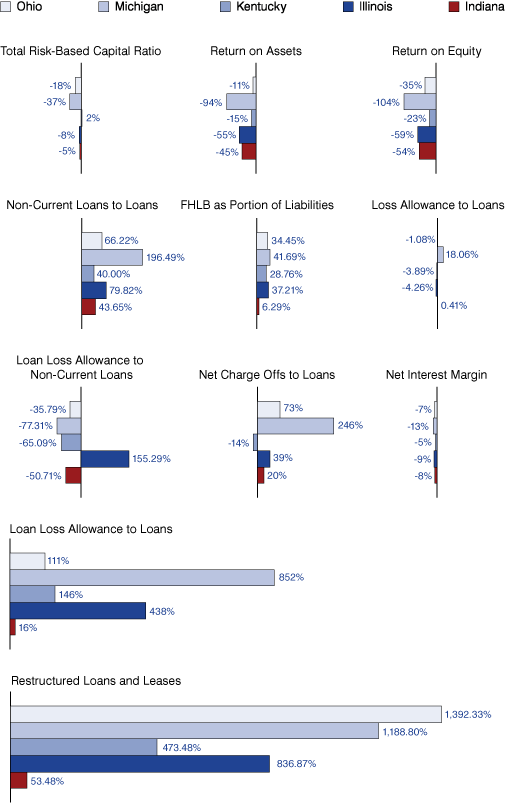
Source: Federal Deposit Insurance Corporation, www.fdic.gov/
A weakening economy or the inability of borrowers to repay results in charge-offs, and charge-offs reduce the capital base of a bank. So the large decline in capital for Michigan may be related to the large increase in net charge-offs to loans. On the other hand, Kentucky actually saw a decline in charge-offs, and an increase in the total risk-based capital ratio.
Within Indiana, the Lawrenceburg-Madison-New Albany and Indianapolis regions saw the largest declines in the TRBCR. To the contrary, the Evansville and Gary-South Bend regions saw small increases in their respective TRBCR (see Figure 2 and Figure 3).
Figure 2: Indiana Three-Digit Zip Codes by Region
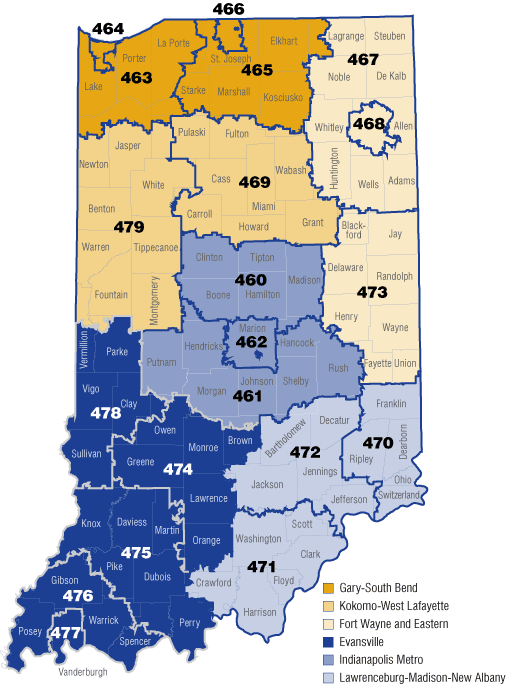
Source: Indiana Business Research Center
Figure 3: Percent Change in Total Risk-Based Capital Ratio, 2002 to 2008

Source: Federal Deposit Insurance Corporation, www.fdic.gov/
Profitability Ratios
All profitability ratios examined exhibited declines over the entire period. Michigan experienced declines in return on assets and return on equity ratios much steeper than neighboring states. When the two ratios are combined, Kentucky observed the smallest declines. It is no coincidence that states experiencing the smallest decline in capital ratios also experienced the smallest decline in return on equity.
Net interest margin is determined by the difference between interest paid on funding assets and interest earned on earning assets, or as the spread between rates earned on loans and rates paid on deposits. The change in net interest margin across all states was approximately the same. The cost of funding assets and the yield on earning assets are both primarily driven by external capital market influences and Federal Reserve monetary policy. Across the board, all states experienced declines in net interest margins. Michigan did observe the largest decline, and this decline shows up in the larger declines in return on equity and assets.
The same was true in Indiana—all regions experienced a negative percentage change in net interest margin (see Figure 4). Evansville saw the smallest decline while Fort Wayne and Eastern saw the largest decline.
Figure 4: Percent Change in Net Interest Margin, 2002 to 2008
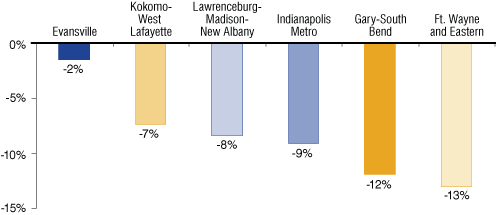
Source: Federal Deposit Insurance Corporation, www.fdic.gov/
Across Indiana, all regions realized a negative percentage change in return on assets (see Figure 5). The Gary-South Bend region saw the largest decline in return on assets. All other regions saw return on assets decline by at least 50 percent from 2002 to 2008.
Figure 5: Percent Change in Return on Assets, 2002 to 2008
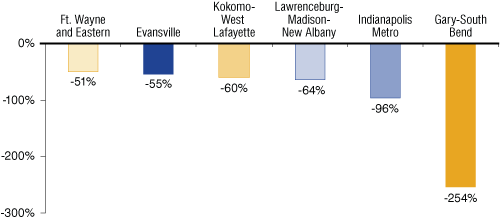
Source: Federal Deposit Insurance Corporation, www.fdic.gov/
Similar results are observed for return on equity (see Figure 6). The Gary-South Bend region did see a small increase in its return on equity ratio, however. All other regions saw declines in bank return on equity ratios that hovered around a 50 percent drop.
Figure 6: Percent Change in Return on Equity, 2002 to 2008

Source: Federal Deposit Insurance Corporation, www.fdic.gov/
Loans and Delinquencies
All states are experiencing an increase in non-current loans to loans. Consistent with the bank capital and profitability ratios, Kentucky has experienced the smallest increase in non-current loans to loans. Michigan, meanwhile, has seen its non-current loans to loans almost triple.
Even though all five states are showing an increase in the percentage of non-current loans to loans, not all have generated a simultaneous increase in loss allowance to loans. Only Michigan and Indiana exhibit an increase in loan loss allowances to loans. Michigan is expectedly showing the largest increase, given the significantly higher level of non-current loans to loans.
However, when one observes loan loss allowance to non-current loans, one may arrive at a different conclusion. Declines in loan loss allowances to non-current loans occurred in all states except Illinois. As non-current loans increase, the likelihood of utilizing loan loss allowances increases as well. Hence, an increase in non-current loans should be accompanied by a corresponding increase in loan loss allowances. However, even as non-current loans have increased, banks in all states have not increased loan loss allowances in proportion to the level of non-current loans. A proportionate increase in loan loss reserves and non-current loans should produce a constant loan loss reserves to non-current loans ratio.
Michigan and Ohio show the largest increases in restructured loans and leases. No doubt, this is in response to the increase in non-current loans stemming from higher unemployment rates and auto-related job losses.
All regions within Indiana are experiencing an increase in non-current loans to loans (see Figure 7). The Evansville region is seeing the smallest increase in non-current loans, while the Lawrenceburg-Madison-New Albany and Gary-South Bend regions are experiencing the highest increases.
Figure 7: Percent Change in Non-Current Loans to Loans, 2002 to 2008
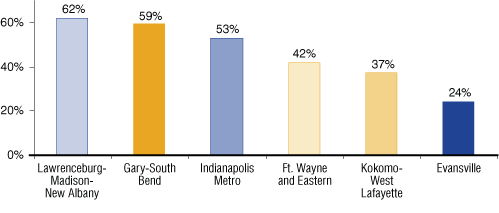
Source: Federal Deposit Insurance Corporation, www.fdic.gov/
Indiana banks have not increased loan loss allowances in response to the higher level of non-current loans, however. The loss allowance to non-current loans ratio decreased in all geographic areas across Indiana (see Figure 8). Areas with the highest increase in non-current loans to loans are also realizing the largest decline in loan loss allowance to non-current loans. So this mismatch between the increase in non-current loans and the corresponding decrease in loan loss allowances to non-current loans could represent a potential concern.2 This mismatch implies that banks could see additional declines in capital and subsequent profitability challenges.
Figure 8: Percent Change in Loan Loss Allowance to Non-Current Loans, 2002 to 2008
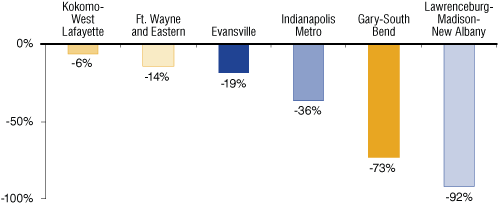
Source: Federal Deposit Insurance Corporation, www.fdic.gov/
Figure 9 through Figure 11 show additional indicators by Indiana region.
Figure 9: Percent Change in Retained Earnings to Average Equity, 2002 to 2008
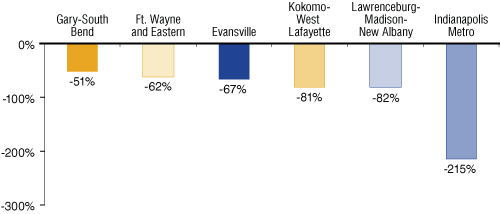
Source: Federal Deposit Insurance Corporation, www.fdic.gov/
Figure 10: Percent Change in Loan Loss Allowance to Loans, 2002 to 2008
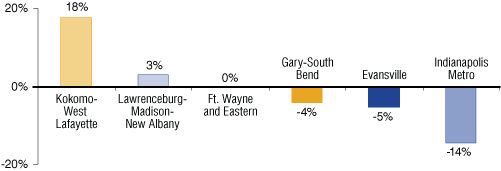
Source: Federal Deposit Insurance Corporation, https://www.fdic.gov/
Figure 11: Percent Change in Net Loans and Leases to Deposits, 2002 to 2008
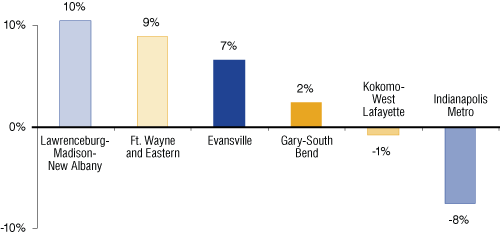
Source: Federal Deposit Insurance Corporation, www.fdic.gov/
Funding Sources
Much of the financial crisis has dealt with the issue of funding sources and general liquidity. Even though total deposits are up across all states, deposits as a percent of liabilities declined from 2002 to 2008. This suggests that banks have increased their reliance on other sources of funding. While only two states saw increases in federal funds as a percent of total liabilities, all states experienced significant increases in FHLB advances as a percent of total liabilities. So it appears that banks in all five states are relying more on advances from the Federal Home Loan Banks.
Summary
Overall, Indiana banking is in a relatively better position than its neighbors to the west, east, and north. Michigan bank performance lags all five states examined, while Kentucky leads the group in key ratios. State averages point to declines in profitability and increases in non-current loans. All states, with the exception of Kentucky, also observe declines in the total risk-based capital ratio examined.
Across Indiana, all regions show declines in profitability at variable levels, and all regions are showing an increase in non-current loans. A potential area of concern is the increase in non-current loans and the corresponding decrease in loan loss allowances expressed as a percent of non-current loans. This mismatch implies that banks could see additional declines in capital and subsequent profitability challenges.
Notes
- Matt Woolsey, "America's Hardest-Hit Foreclosure Spots," Forbes.com,
www.forbes.com/2008/01/27/homes-underwater-foreclosure-forbeslife-cx_mw_0128realestate_print.html. Retrieved January 28, 2009. - Brian Bandell, "Banks' Losses Eat Into Reserves," South Florida Business Journal, June 6, 2008, Alistair Barr, "Banks Reserves Don't Keep Up With Loan Losses, FDIC Says," MarketWatch, November 25, 2008. All retrieved January 31, 2009.
Uric Dufrene
Sanders Chair in Business, Indiana University Southeast
Tom Lambert
Lecturer in Economics, Indiana University Southeast
